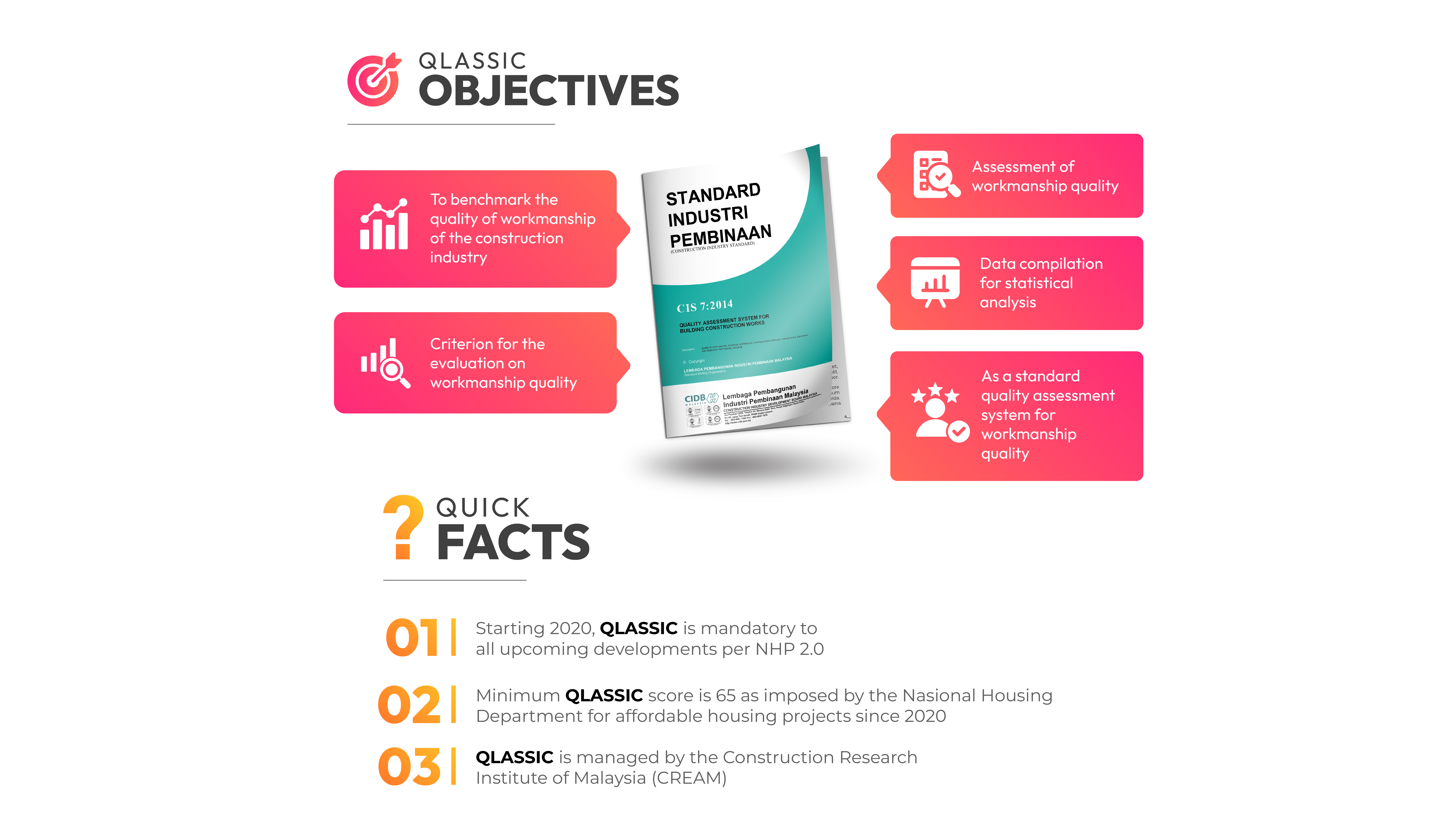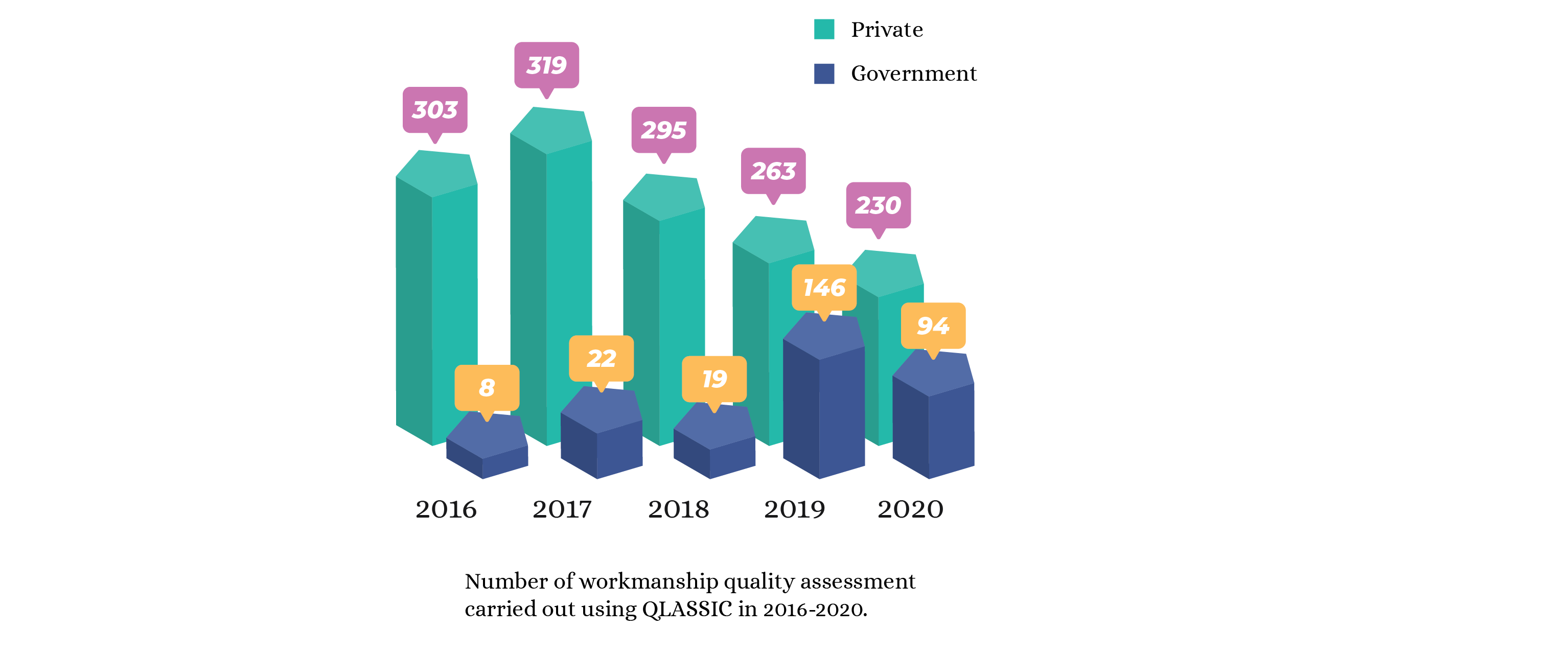Essentially, the Quality Assessment System in Construction or QLASSIC is an independentmethod to access and evaluate primarily on the quality of workmanship and building projects based on the Construction Industry Standard (CIS 7:2014).
Quality, Safety & Professionalism
The prerequisites in transforming the national construction industry into a responsible and developed industry are quality, safety and professionalism. As such, QLASSIC embodies the requirement to increase emphasis on quality, improve workplace safety andworkers' amenities and improve ease of doing business by addressing regulatory constraints. Since its inception, the average national QLASSIC Score saw a rose from 69% in 2014 to 72% in 2020, signifying increased inclination of quality of workmanship among the industry stakeholders.
QLASSIC: OBJECTIVES
Bearing credible success throughout the previously deployed Construction Industry Transformation Program (CITP 2016-2020), QLASSIC is ever present as another initiative by the Construction Industry Development Board (CIDB) to foster improvements of the national construction industry.
From 2016 to 2020, QLASSIC saw increased take-up rate in the evaluations of construction projects within the country, with a total of 1699 projects assessed via QLASSIC.
It is non-arguable that the responsibility of the qualified person to ensure that the quality of the construction works conforms to approved standards, practices, specifications and drawings, as specified in the contract. To aid the process, QLASSIC is designed as a complementary tool to the normal contractual drawings and specifications of a project. However, it is not intended to be used independently as working specifications.
In a nutshell, the Quality Assessment System for Building Construction Works covers four main components, which are structural works, architectural works, M&E works and external works. Assessments on the workmanship are carried out based on CIS 7 standard and marks are awarded if the workmanship complies with the quality standard. These marks are then summed up to give a total quality score (%) for the building project. However, the assessment excludes works such as piling, foundation and substructure works, which are heavily equipment-based and called under separate contracts or subcontracts. The building is assessed primarily on workmanship standards achieved through site inspection and field testing. For structural and M&E works, assessment is carried out throughout the construction process. For completed building projects, the assessment is done for architectural, M&E fittings and external works.
We also took a look at how our QLASSIC awareness efforts under the Construction Industry Transformation Programme 2016 (CITP) performed - the results are promising and will continue to improve once the pandemic has been contained.
Datuk Ir. Ahmad 'Asri Abdul Hamid Chief Executive, CIDB Malaysia
There are four category of building assessed using QLASSIC :
- Category A (Landed housing) – Detached, semi-detached, terrace and cluster houses.
- Category B (Stratified housing) – Flats, apartments, condominiums, service apartments, small office home office (SOHO) and town houses.
- Category C (Public/commercial/industrial buildings without centralised cooling system) – Office buildings, schools, factories, warehouses, workshops, hangers, small office flexible office (SOFO), small office virtual office (SOVO), religious buildings, stadiums, community halls, hospitals, airports, universities, colleges, police stations, etc.
- Category D (Public/commercial/industrial buildings with centralised cooling system) – Office buildings, schools, factories, warehouses, workshops, hangers, small office flexible office (SOFO), small office virtual office (SOVO), religious buildings, stadiums, community halls, hospitals, airports, universities, colleges, police stations, etc.
Moving Forward
CIDB is continuously developing and improving standards, policies, operating procedures and solutions tailored towards a pre-emptive and proactive approach intended to reduce and eventually eliminate construction site hazards. To learn more about QLASSIC, visithttps://qlassic.cidb.gov.my/assessment/. Reach out to us at 1300-88-2432 (CIDB Careline) or book an appointment to meet us in our office located at Level 23, Sunway Putra Tower, No. 100, Jalan Putra, 50350 Kuala Lumpur.
Construction Industry Development Board (CIDB)
Tingkat 11, CIDB 520
The MET Corporate Towers
No 20 Jalan Dutamas 2
50480 Kuala Lumpur, Malaysia
Tel: 0340477000
Email: cidb@cidb.gov.my
Access Portal SMART CIDB on your mobile device by scanning the QR code.


